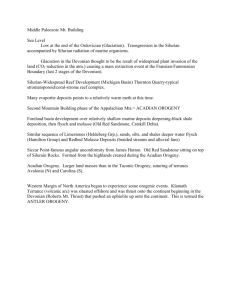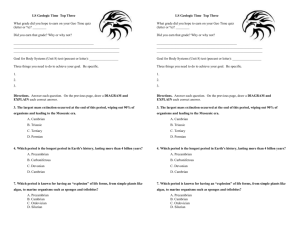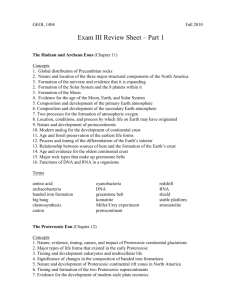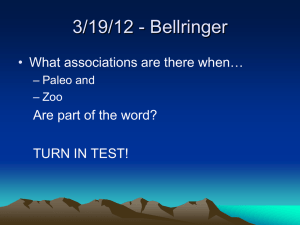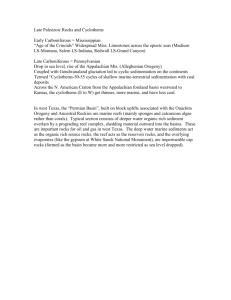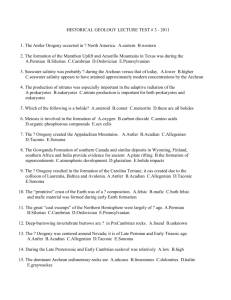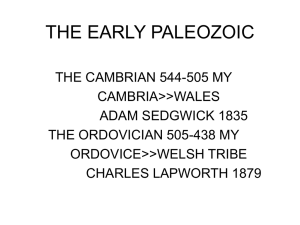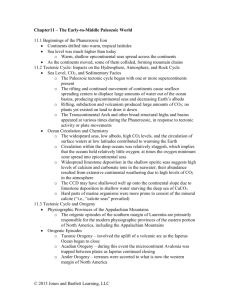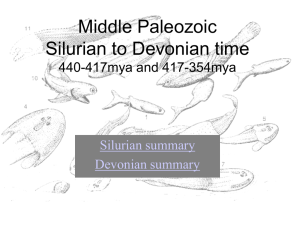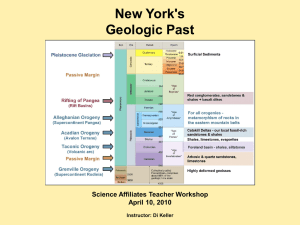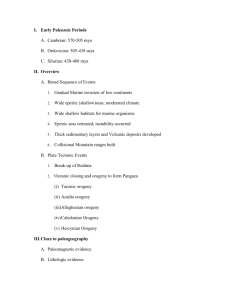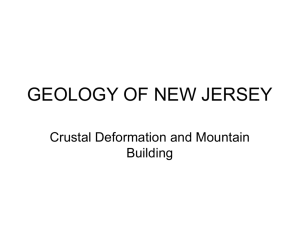Review
advertisement
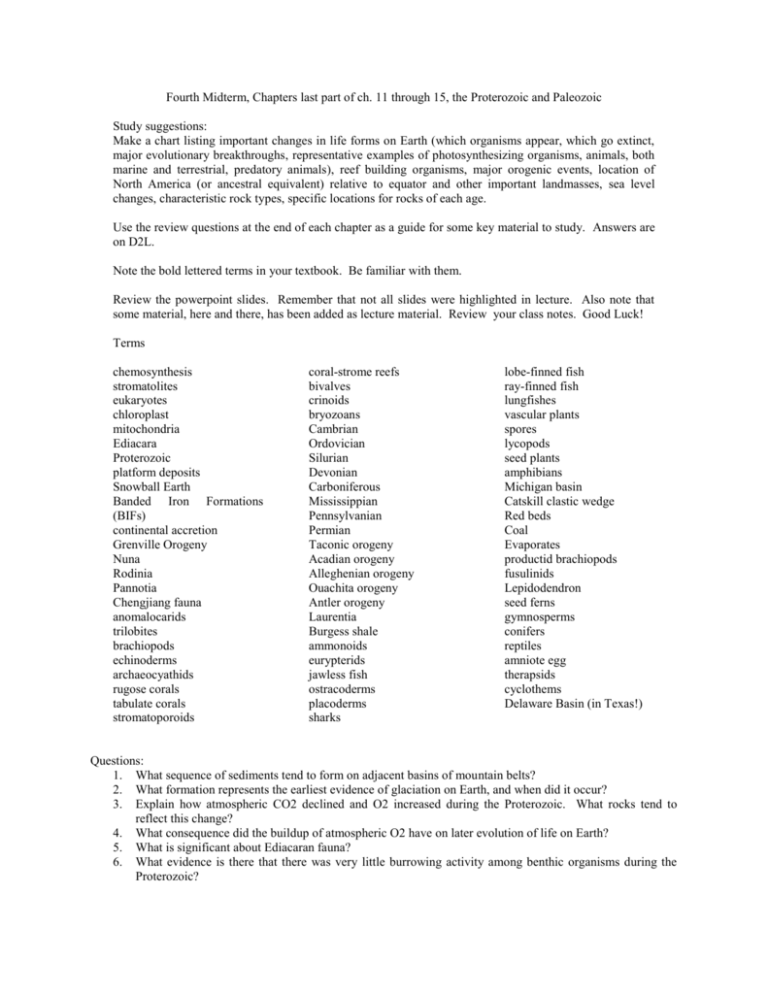
Fourth Midterm, Chapters last part of ch. 11 through 15, the Proterozoic and Paleozoic Study suggestions: Make a chart listing important changes in life forms on Earth (which organisms appear, which go extinct, major evolutionary breakthroughs, representative examples of photosynthesizing organisms, animals, both marine and terrestrial, predatory animals), reef building organisms, major orogenic events, location of North America (or ancestral equivalent) relative to equator and other important landmasses, sea level changes, characteristic rock types, specific locations for rocks of each age. Use the review questions at the end of each chapter as a guide for some key material to study. Answers are on D2L. Note the bold lettered terms in your textbook. Be familiar with them. Review the powerpoint slides. Remember that not all slides were highlighted in lecture. Also note that some material, here and there, has been added as lecture material. Review your class notes. Good Luck! Terms chemosynthesis stromatolites eukaryotes chloroplast mitochondria Ediacara Proterozoic platform deposits Snowball Earth Banded Iron Formations (BIFs) continental accretion Grenville Orogeny Nuna Rodinia Pannotia Chengjiang fauna anomalocarids trilobites brachiopods echinoderms archaeocyathids rugose corals tabulate corals stromatoporoids coral-strome reefs bivalves crinoids bryozoans Cambrian Ordovician Silurian Devonian Carboniferous Mississippian Pennsylvanian Permian Taconic orogeny Acadian orogeny Alleghenian orogeny Ouachita orogeny Antler orogeny Laurentia Burgess shale ammonoids eurypterids jawless fish ostracoderms placoderms sharks lobe-finned fish ray-finned fish lungfishes vascular plants spores lycopods seed plants amphibians Michigan basin Catskill clastic wedge Red beds Coal Evaporates productid brachiopods fusulinids Lepidodendron seed ferns gymnosperms conifers reptiles amniote egg therapsids cyclothems Delaware Basin (in Texas!) Questions: 1. What sequence of sediments tend to form on adjacent basins of mountain belts? 2. What formation represents the earliest evidence of glaciation on Earth, and when did it occur? 3. Explain how atmospheric CO2 declined and O2 increased during the Proterozoic. What rocks tend to reflect this change? 4. What consequence did the buildup of atmospheric O2 have on later evolution of life on Earth? 5. What is significant about Ediacaran fauna? 6. What evidence is there that there was very little burrowing activity among benthic organisms during the Proterozoic? 7. 8. 9. 10. 11. 12. 13. 14. 15. 16. 17. 18. 19. 20. 21. 22. 23. 24. 25. 26. 27. 28. 29. 30. 31. 32. 33. 34. 35. 36. 37. 38. 39. 40. 41. 42. 43. 44. 45. 46. 47. 48. “Cap carbonates” represent a warming period following which period of later Proterozoic glaciation? (answer: the “snowball Earth” from about 580 to 720 million years ago) What are some examples of Proterozoic age sedimentary sequences found in North America? (answer: Belt Supergroup in Montana and the Unkar and Chuar groups in Grand Canyon, Arizona) How did the Keweenawan basalts form? Where are they located? What economic material do they contain? What name is given to the ancestral North American continent? (answer: Laurentia) When and where did the Grenville Orogeny occur? What is the earliest known supercontinent which included Laurentia called? About when did it form? About when did Rodinia come together? What evolutionary breakthrough occurred at the beginning of the Cambrian? What are examples of organisms that first appear at the beginning of the Cambrian? What is significant about the Burgess Shale and Chengjiang fauna? What kind of environment is represented by the Burgess Shale? What is a major reef-forming organism of the Cambrian? (answer: archeocyathids) What is an example of the earliest vertebrate? (answer: conodonts) How did Ordovician life differ from Cambrian life? What new predatory organism appeared in the Ordovician? What what were major reef-forming organisms in the Ordovician? Why did stromatolites decline during Cambrian and Ordovician time? Where can one find exposed rocks of the early Paleozoic? (southeastern California/Death Valley area/south and western Nevada) Explain the different orogenic events (names, and what kind of mountain building processes) and when they happened, that led to the formation of the Appalachian mountain belt. Where was Laurentia situated on Earth in the Cambrian? (answer: equator) Where was Gondwanaland situated throughout the Cambrian and Ordovician? (answer: at or near the South Pole) What kind of climate change occurred at the end of the Ordovician, and was connected with a mass extinction event? What new predatory organism appeared in the Silurian? (answer: eurypterid, looks like an aquatic scorpion) What were some evolutionary changes noted in fossils of fish during the Silurian and Devonian? What is an example of a modern day fish that first appears at this time? (answer: shark, also ray-finned fish) What is the evolutionary significance of lungfish? What were some evolutionary changes noted in fossils of plant organisms during the Silurian and Devonian? What effect does the expansion of plants onto land have on global climate from the Devonian into the Carboniferous? Where in North America can one find examples of substantial reef/barrier reef deposits from the Silurian? (answer: Michigan Basin) What orogenic event is represented by the angular unconformity at Siccar Point, seen in figure 1-22 in chapter 1, pg. 22 of your textbook? What mountains are associated with the Antler Orogeny? Which coast of ancestral North America was affected by the Antler Orogeny? Where in North America can one find examples of substantial reef/barrier reef deposits from the Devonian? (answer: western Canada/western U.S.) What organisms either first appear or flourish during the Carboniferous? What new major reef-forming organism appeared during the Carboniferous? What is the distinctive type of rock that formed during the Carboniferous? What common tree-like plant was found as a fossil in this type of rock? What broad category of seed plants formed upland forests during the Carboniferous and Permian? How did land animals diversify through this time? Why did insects (arthropods) grow to large size during this time? How did therapsids differ from contemporary reptiles? What evidence do we see in North America of Pangea coming together in the late Paleozoic? What is a cyclothem? How did they form? Where are Carboniferous coal deposits abundant in North America? 49. Where in North America can one find examples of substantial reef/barrier reef deposits from the Permian? (answer: west Texas and SE New Mexico) 50. What caused the major extinction event at the end of the Permian?
